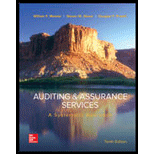
Auditing & Assurance Services: A Systematic Approach (Irwin Accounting)
10th Edition
ISBN: 9780077732509
Author: William F Messier Jr, Steven M. Glover Associate Professor, Douglas F. Prawitt Associate Professor
Publisher: McGraw-Hill Education
expand_more
expand_more
format_list_bulleted
Question
Chapter 9, Problem 9.16MCQ
To determine
Concept Introduction:
Sampling is the method of selecting few items to check from the entire population under examination. Auditors apply sampling method while performing their
Sampling can be statistical or non statistical.
To choose: the effect of increase in tolerable misstatement and assessed level of control risk.
Expert Solution & Answer
Want to see the full answer?
Check out a sample textbook solution
Students have asked these similar questions
Answer in step by step with explanation.
Don't use Ai and chatgpt.
Article: Current Bank Problem Statement
The general problem to be surveyed is that leaders lack an understanding of how to address job demands, resulting in an increase in voluntary termination, counterproductive workplace outcomes, and a loss of customers.
Bank leaders discovered from customer surveys that customers are closing accounts because their rates are not competitive with area credit unions.
Job demands such as a heavy workload interfered with employee performance, leading to decreased job performance.
Healthcare employees who felt the organization’s benefits were not competitive were more likely to quit without notice, resulting in retention issues for the organization.
Information technology leaders who provide job resources to offset job demand have seen an increase in (a) new accounts, (b) employee productivity, (c) positive workplace culture, and (d) employee retention.
The specific problem to be addressed is that IT technology leaders in the information technology…
How to rewrite the problem statement, correcting the identified errors of the Business Problem Information and the current Bank Problem Statement (for the discussion: Evaluating a Problem Statement)
Chapter 9 Solutions
Auditing & Assurance Services: A Systematic Approach (Irwin Accounting)
Ch. 9 - Prob. 9.1RQCh. 9 - Prob. 9.2RQCh. 9 - Prob. 9.3RQCh. 9 - Prob. 9.4RQCh. 9 - Prob. 9.5RQCh. 9 - Prob. 9.6RQCh. 9 - Prob. 9.7RQCh. 9 - Prob. 9.8RQCh. 9 - Prob. 9.9RQCh. 9 - Prob. 9.10RQ
Ch. 9 - Prob. 9.11MCQCh. 9 - Prob. 9.12MCQCh. 9 - Prob. 9.13MCQCh. 9 - Prob. 9.14MCQCh. 9 - Prob. 9.15MCQCh. 9 - Prob. 9.16MCQCh. 9 - Prob. 9.17MCQCh. 9 - Prob. 9.18MCQCh. 9 - Prob. 9.19MCQCh. 9 - Prob. 9.20MCQCh. 9 - Prob. 9.21PCh. 9 - Prob. 9.22PCh. 9 - Prob. 9.23PCh. 9 - Prob. 9.24PCh. 9 - Prob. 9.25PCh. 9 - Prob. 9.26P
Knowledge Booster
Similar questions
- Don't used hand raiting and don't used Ai solutionarrow_forward3 years ago, you invested $9,200. In 3 years, you expect to have $14,167. If you expect to earn the same annual return after 3 years from today as the annual return implied from the past and expected values given in the problem, then in how many years from today do you expect to have $28,798?arrow_forwardPlease Don't use Ai solutionarrow_forward
- Ends Feb 2 Discuss and explain in detail the "Purpose of Financial Analysis" as well as the two main way we use Financial Ratios to do this.arrow_forwardWhat is the key arguments of the supporters of the EITC? Explain.arrow_forwardWhat is the requirements to be eligible to receive the EITC? Explain.arrow_forward
- Adidas annual income statement 2022-2023 and 2024arrow_forwardNikes annual balance sheet and income statement for 2022-2023 and 2024arrow_forwardWhat is the value at the end of year 3 of a perpetual stream of $70,000 semi-annual payments that begins at the end of year 7? The APR is 12% compounded quarterly.arrow_forward
arrow_back_ios
SEE MORE QUESTIONS
arrow_forward_ios
Recommended textbooks for you
 Auditing: A Risk Based-Approach (MindTap Course L...AccountingISBN:9781337619455Author:Karla M Johnstone, Audrey A. Gramling, Larry E. RittenbergPublisher:Cengage Learning
Auditing: A Risk Based-Approach (MindTap Course L...AccountingISBN:9781337619455Author:Karla M Johnstone, Audrey A. Gramling, Larry E. RittenbergPublisher:Cengage Learning Auditing: A Risk Based-Approach to Conducting a Q...AccountingISBN:9781305080577Author:Karla M Johnstone, Audrey A. Gramling, Larry E. RittenbergPublisher:South-Western College Pub
Auditing: A Risk Based-Approach to Conducting a Q...AccountingISBN:9781305080577Author:Karla M Johnstone, Audrey A. Gramling, Larry E. RittenbergPublisher:South-Western College Pub

Auditing: A Risk Based-Approach (MindTap Course L...
Accounting
ISBN:9781337619455
Author:Karla M Johnstone, Audrey A. Gramling, Larry E. Rittenberg
Publisher:Cengage Learning

Auditing: A Risk Based-Approach to Conducting a Q...
Accounting
ISBN:9781305080577
Author:Karla M Johnstone, Audrey A. Gramling, Larry E. Rittenberg
Publisher:South-Western College Pub